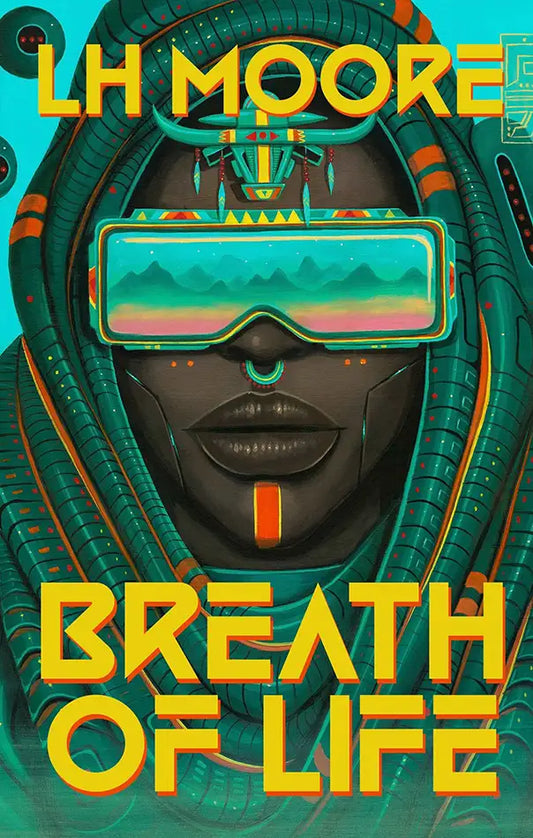
I grew up loving fantasy, and at some point my friends started introducing me to science fiction with fantasy elements. Whether it was the genetically-created dragons of Anne McCaffery’s Pern series or the otherworldly Mrs. Who, Whatsit, and Which in Madeleine L’Engle’s A Wrinkle in Time, I seemed to naturally gravitate towards works that combined scientific concepts and fantasy tropes.
Now that I read and study science fiction for a living, I have come to understand how the labels of “soft science fiction” or “YA literature” are often applied to texts that don’t seem to fit a standard version of science fiction, particularly texts that include young female protagonists (I am not necessarily saying that the categories are to blame; reader and publisher assumptions about these categories are the issue). But if science is a way of understanding the world, then what about cultures whose views of the world don’t stop at humanity’s limited understanding? What about cultures who don’t separate out “science” from other cultural teachings? Texts that offer non-Eurocentric depictions of science or ones that combine science fiction and fantasy elements are the texts that most interest me.
Many non-Eurocentric cultures teach a way of knowing the world that accounts for the unknown and fantastic, and many ways of knowing the world like Santeria or Vodun are labeled as “black magic” because they are not understood by European colonizers and their descendants. I recently completed an article for the Routledge Handbook of Co-Futurisms that examines the connections between Santeria and Quantum Physics in Carlos Hernandez’s short story, “The Assimilated Cuban’s Guide to Quantum Santeria.” The more I delved into Santeria and other forms of Indigenous knowledge, the more I realized that much of the “cutting-edge” science being performed by Eurocentric scientists is already embedded in the cultural teachings of many non-Eurocentric cultures. The effects of gender and racial bias in scientific communities means that many non-Eurocentric teachings and scientists of color have been suppressed or silenced, a fact that is intrinsically linked to the definitions of science that help define the genre of science fiction. (For a discussion of the effects of white supremacy on science, see The Disordered Cosmos: A Journey into Dark Matter, Spacetime, and Dreams Deferred by Chanda Prescod-Weinstein.)
At this point, I need to differentiate between texts that push the boundaries of science in science fiction, but are strictly science fiction, and texts that blend elements of science fiction and fantasy. There are several texts that I enjoy reading that blend science fiction elements with established fantasy tropes or characters. One good example is Darcie Little Badger’s Elatsoe, which includes references to biology, magic, fairies, monsters, ghosts, and vampires. While the idea of tiny magical peoples and the term “fairy” are not solely found in European folklore, the additional presence of vampires and monsters seems to indicate that Little Badger is intentionally including well-known fantasy and supernatural species in her novel.
Another example of this trend is N.K. Jemison’s choice to use the term “magic” in the third book of her Broken Earth trilogy. Jemison is the author of multiple science fiction, fantasy, and science fiction/fantasy texts, so her choice to use the term “magic” in a series that, up until then, could have been defined as solely science fiction is influenced by her desire to give a “rocket-shaped middle finger” to the science fiction fanboys that organized hate campaigns against her Hugo nominations. (This quote comes from Jemison's 2018 Hugo acceptance speech.) Authors like Little Badger and Jemisin are aware of the genre boundaries that many scholars and fans have used to divide science fiction and fantasy, and they play with these boundaries for different reasons. For Jemisin, it is a response to negative assumptions about her science fiction writing, while for Little Badger, it is a result of being included in a culture (Lipan Apache) that does not draw a hard divide between science and spirituality, or between perceived reality and the unknown.
But there are also science fiction texts that include elements of non-Eurocentric sciences that are often labeled as belief systems rather than science. So a text like Rivers Solomon’s An Unkindness of Ghosts, which tells the story of a healer who lives on a generation starship that also houses ghosts, becomes very difficult to place. The presence of ghosts or deities that interact with mortals doesn’t always make a text fantasy or horror; the literary category of magical realism exists specifically to demarcate realistic texts with fantastic, religious, or mythical elements from fantasy. Whether a text is magical realism or fantasy depends heavily on the culture the author is writing from and their experiences with those specific cultural elements.
I want to be clear that I am not drawing this line to add more barriers to authors writing science fiction and fantasy texts with non-Eurocentric cultural elements. I am making the point that fans and scholars must be careful when discussing non-Eurocentric texts as fantasy. There is a very real history of white colonizers using perceived non-rationality against Indigenous cultures by linking them to “primitive” beliefs rather than “rational” science. Miriam C. Brown Spiers notes in her introduction to Encountering the Sovereign Other: Indigenous Science Fiction that many Native traditions such as the Medicine Man or Woman and skinwalkers are often depicted in Eurocentric cultures as mystical or magical; she points to J.K. Rowling’s decision to include these Indigenous figures in her story series History of Magic in North America as a prominent example of this trend (xvi).
Spiers makes the argument that labeling Indigenous cultural figures as fantastical or magical portrays Indigenous cultures as naïve peoples living in a romanticized past and, therefore, undeserving of present-day respect. So I need to be clear that Nnedi Okorafor’s category of “Africanjujuism,” the term she created to discuss her African-based fantasy texts, is not fantasy because of the references to Juju; in the case of her Akata Witch world, these texts are fantasy because of the presence of portals (secret communities of Leopard people that can only be accessed by other Leopard people and which involve the crossing of a magical border) and intrusion (magic seeping into reality). I am discussing Okorafor’s series here because she describes the power-system of the Akata world in Akata Woman as “Quantum Physics at its most Jujufied.” Like Hernandez, Okorafor’s reference to Quantum Physics draws attention to the commonalities between Indigenous teachings and “cutting edge” Eurocentric sciences. Juju and science work together in Okorafor’s work, and magic creates the frame for the multi-layered world that she creates in the Akata Witch series.
Texts that combine or blur the science fiction and fantasy genres interest me because these works often employ liminal spaces that push the limits of both genres. Unfortunately, these works also risk being punished by publishers and readers because of their fluidity. One of the best new contemporary examples of a text that expertly blends elements from the science fiction and fantasy genres is Ryka Aoki’s Light from Uncommon Stars. Aoki is a Japanese American author, performer, and trans activist. In Light from Uncommon Stars, she creates a dazzling present world where demons can affect the mortal realm, and where alien refugees run donut shops. While the concept of demons or hell doesn’t necessarily guarantee that this text is fantasy, Aoki references European cultures throughout her novel, most commonly through references to European classical music, and makes the demon in her novel, Tremon Philippe, a suit-wearing Francophone/Anglophone man with Eurocentric views about what makes people “cultured.” She also makes the technologically advanced alien refugees Asian (although their true forms are multicolored with additional joints).
It is not surprising that a text that deftly moves between references to hell and intergalactic travel would have a main character who is trans. Aoki is an outspoken advocate for the LGBTQIA community, and she notes in interviews that, ultimately, her work is about finding a shared humanity for all peoples. When asked about her choice to write her first science fiction novel, Aoki explains:
“The trick for me doing this was to not sacrifice my family, my chosen family, my neighborhood in order to reach for the stars. Rather than think of a future where either, one, everybody’s queer, so it doesn’t really matter, or two, everything is the same and we all have to be careful because it’s still a very cisgender and very patriarchal society—I wanted to cut against both of those things. The way I did that was to combine some very out-there premises—Vietnamese donut shop, aliens coming in from across the galaxy who are plum-colored—with the very real sense that sometimes when you’re a trans woman of color, you’re doing sex work, and it’s not good or bad, it’s how much you’re getting paid.”
See “We Do What We Can: A Conversation with Ryka Aoki”, The Rumpus, 2021, https://therumpus.net/2021/12/13/the-rumpus-interview-with-ryka-aoki/.
This willingness of authors like Aoki to write across what was once a perceived gulf between science fiction and fantasy demonstrates a breaking of not only the perceived barrier between these genres, but also the Eurocentric binary of “rational” vs. “primitive” cultural ideas. And I am here for all of it; I wrote in my contribution to the Journal of the Fantastic in the Arts recent Future of Fantasy Studies Symposium issue that I want to see more of this genre-bending work. Reading should bridge us elsewhere, not loop us back around to where we’ve already been. False gulfs create homogeneity and stagnation. I am excited to read these stories because they are the best representation of how the genres of science fiction and fantasy can work to be more inclusive spaces overall.









